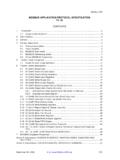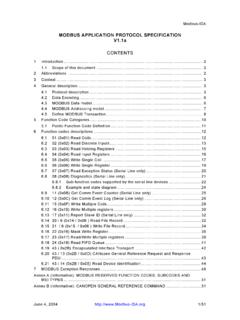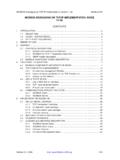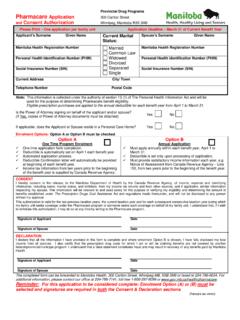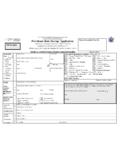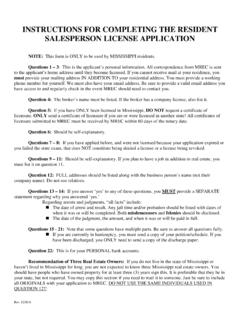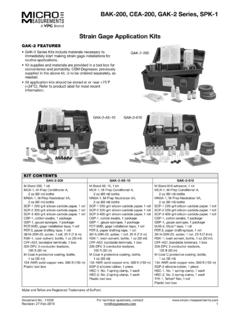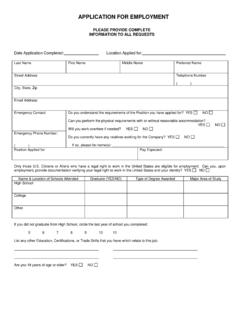Transcription of MODBUS APPLICATION PROTOCOL SPECIFICATION V1
1 April 26, 2012 1/50 MODBUS APPLICATION PROTOCOL SPECIFICATION CONTENTS 1 Introduction .. 2 Scope of this document .. 2 2 Abbreviations .. 2 3 Context .. 3 4 General description .. 3 PROTOCOL description .. 3 Data Encoding .. 5 MODBUS Data model .. 6 MODBUS Addressing model .. 7 Define MODBUS Transaction .. 8 5 Function Code Categories .. 10 Public Function Code Definition .. 11 6 Function codes descriptions .. 11 01 (0x01) Read Coils .. 11 02 (0x02) Read Discrete Inputs .. 12 03 (0x03) Read Holding Registers .. 15 04 (0x04) Read Input Registers.
2 16 05 (0x05) Write Single Coil .. 17 06 (0x06) Write Single Register .. 19 07 (0x07) Read Exception Status (Serial Line only) .. 20 08 (0x08) Diagnostics (Serial Line only) .. 21 Sub-function codes supported by the serial line devices .. 22 Example and state diagram .. 24 11 (0x0B) Get Comm Event Counter (Serial Line only) .. 25 12 (0x0C) Get Comm Event Log (Serial Line only) .. 26 15 (0x0F) Write Multiple Coils .. 29 16 (0x10) Write Multiple registers .. 30 17 (0x11) Report Server ID (Serial Line only) .. 31 20 (0x14) Read File Record.
3 32 21 (0x15) Write File Record .. 34 22 (0x16) Mask W rite Register .. 36 23 (0x17) Read/Write Multiple registers .. 38 24 (0x18) Read FIFO Queue .. 40 43 ( 0x2B) Encapsulated Interface Transport .. 41 43 / 13 (0x2B / 0x0D) CANopen General Reference Request and Response PDU .. 42 43 / 14 (0x2B / 0x0E) Read Device Identification .. 43 7 MODBUS Exception Responses .. 47 Annex A (Informative): MODBUS RESERVED FUNCTION CODES, SUBCODES AND MEI TYPES .. 50 Annex B (Informative): CANOPEN GENERAL REFERENCE COMMAND .. 50 MODBUS APPLICATION PROTOCOL SPECIFICATION MODBUS April 26, 2012 2/50 1 Introduction Scope of this document MODBUS is an APPLICATION layer messaging PROTOCOL , positioned at level 7 of the OSI model, which provides client/server communication between devices connected on different types of buses or networks.
4 The industry s serial de facto standard since 1979, MODBUS continues to enable millions of automation devices to communicate. Today, support for the simple and elegant structure of MODBUS continues to grow. The Internet community can access MODBUS at a reserved system port 502 on the TCP/IP stack. MODBUS is a request/reply PROTOCOL and offers services specified by function codes. MODBUS function codes are elements of MODBUS request/reply PDUs. The objective of this document is to describe the function codes used within the framework of MODBUS transactions.
5 MODBUS is an APPLICATION layer messaging PROTOCOL for client/server communication between devices connected on different types of buses or networks. It is currently implemented using: TCP/IP over Ethernet. See MODBUS Messaging Implementation Guide Asynchronous serial transmission over a variety of media (wire : EIA/TIA-232-E, EIA-422, EIA/TIA-485-A; fiber, radio, etc.) MODBUS PLUS, a high speed token passing network. TCPM odbus on TCPMODBUS APPLICATION LAYERIPE thernetPhysical layerEthernet II orEIA/TIA-485 Master / SlavePhysical layerMODBUS+ / HDLCO therOther Figure 1: MODBUS communication stack References 1.
6 RFC 791, Internet PROTOCOL , Sep81 DARPA 2 Abbreviations ADU APPLICATION Data Unit HDLC High level Data Link Control HMI Human Machine Interface IETF Internet Engineering Task Force I/O Input/Output IP Internet PROTOCOL MAC Media Access Control MB MODBUS PROTOCOL MODBUS APPLICATION PROTOCOL SPECIFICATION MODBUS April 26, 2012 3/50 MBAP MODBUS APPLICATION PROTOCOL PDU PROTOCOL Data Unit PLC Programmable Logic Controller TCP Transmission Control PROTOCOL 3 Context The MODBUS PROTOCOL allows an easy communication within all types of network architectures.
7 Figure 2: Example of MODBUS Network Architecture Every type of devices (PLC, HMI, Control Panel, Driver, Motion control, I/O ) can use MODBUS PROTOCOL to initiate a remote operation. The same communication can be done as well on serial line as on an Ethernet TCP/IP networks. Gateways allow a communication between several types of buses or network using the MODBUS PROTOCOL . 4 General description PROTOCOL description The MODBUS PROTOCOL defines a simple PROTOCOL data unit (PDU) independent of the underlying communication layers.
8 The mapping of MODBUS PROTOCOL on specific buses or network can introduce some additional fields on the APPLICATION data unit (ADU). Additional addressFunction codeDataError checkADUPDUF igure 3: General MODBUS frame PLCPLCHMII/ OI/ OI/ ODriveMODBUS ON TCP/IPGatewayGatewayGatewayMODBUS ON MB+ MODBUS ON RS232 MODBUS ON RS485 DeviceHMIPLCPLCD riveI/ OI/ OI/ OI/ ODeviceMODBUS COMMUNICATIONMODBUS APPLICATION PROTOCOL SPECIFICATION MODBUS April 26, 2012 4/50 The MODBUS APPLICATION data unit is built by the client that initiates a MODBUS transaction.
9 The function indicates to the server what kind of action to perform. The MODBUS APPLICATION PROTOCOL establishes the format of a request initiated by a client. The function code field of a MODBUS data unit is coded in one byte. Valid codes are in the range of 1 .. 255 decimal (the range 128 255 is reserved and used for exception responses). W hen a message is sent from a Client to a Server device the function code field tells the server what kind of action to perform. Function code "0" is not valid.
10 Sub-function codes are added to some function codes to define multiple actions. The data field of messages sent from a client to server devices contains additional information that the server uses to take the action defined by the function code. This can include items like discrete and register addresses, the quantity of items to be handled, and the count of actual data bytes in the field. The data field may be nonexistent (of zero length) in certain kinds of requests, in this case the server does not require any additional information.
